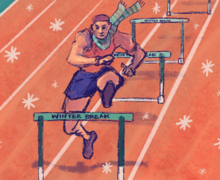Film Review: Syracuse struggles against blitz, stacked box at Louisville
Corey Henry | Senior Staff Photographer
Quarterback Garrett Shrader struggled against Louisville, throwing for just 46 yards in Syracuse's 41-3 loss.
Get the latest Syracuse news delivered right to your inbox.
Subscribe to our sports newsletter here.
Garrett Shrader said the bye week before Syracuse’s matchup against Louisville came at the right time, allowing the Orange to get some much-needed rest after nine straight games.
While the extra time from the bye week helped most units, Syracuse’s offensive line came back disheveled. Airon Servais and Matthew Bergeron were the only mainstays starting at the beginning of the season, while the remaining three lineman either replaced injured players or came in recently after injuries.
With the changes, Syracuse lacked physicality coming back, head coach Dino Babers said, and running back Sean Tucker had his second-worst rushing performance of the entire season, as Louisville was able to confuse the Orange’s offense with a multitude of blitzes and defensive plays.
“Not enough fight, not enough struggle, not enough clawing and scratching,” Babers said. “If you’re not going to play physical, it’s going to be very very hard to win no matter what’s out there,” Babers said.
The lack of physicality also hurt Syracuse’s game through the air as well. Shrader finished with only 46 yards on 18 attempts, his worst performance since earning the starting role.
Here’s a breakdown of Syracuse’s offensive struggles against the Cardinals’ defense:
No time to pass
When extra defenders come up to the line of scrimmage to blitz, the offensive line has a series of “checks” they are supposed to go through in order to make sure every player is on the same page. This was “mentally” a lot, Shrader said, but the quarterback said he thought the Orange still ran their game plan.
“I feel like we executed,” Shrader said. “We ran our gameplan how we thought it would go, but they seemed like they had our number today.”
Yet on crucial passing downs, these checks seemed obsolete. The Cardinals continued to send pressure at Shrader, with only one linebacker staying back on this particular play. After the snap, two of those defenders hesitate, but then beat both tackles, forcing Shrader to step up. Shrader doesn’t get enough time, though, as the one player sitting back — Kenderick Duncan — gets to the quarterback before he can throw.
However, the issue with this play is that Syracuse would never have been able to pull it off against this defense. Even though some blitzes were disguised, this blitz was revealed by Louisville before the snap, allowing SU enough time to change the play. The Orange should’ve called an audible and sent crossing routes at Duncan in the completely wide-open middle of the field. Instead, Syracuse’s offense was forced off the field again, leaving only three points on the board.
Failure to establish Tucker
Tucker entered the matchup against Louisville with 106 yards needed to tie Joe Morris’ single season all-time record for rushing yards — 1,372. But he ended up 11 yards short, even though he asked Babers for the first time in his career to go back into the game in the third quarter.
“Tucker came back and had a conversation with me, and then I put him back in, because that’s what he wanted,” Babers said. “Not for records, for other things which are private.”
The play is at the end of the first half, before Tucker asked Babers to go back in. But the offensive line’s inability to create any movement on this drive is most likely why Babers decided to pull Tucker in the second half.
Tucker gets 10 yards on this play, but around him the rest of his team struggled to create a proper path for the running back to go down. This is a read option play, with Maximilian Mang blocking for Shrader while offensive guard Dakota Davis and Darius Tisdale block for Tucker.
But Tucker goes toward Shrader’s route instead after getting the ball from his quarterback because Davis and Tisdale are unable to clear out their players. And even Shrader’s path is clogged as true freshman Kalan Ellis is unable to stop Malik Clark from getting outside. Shrader is forced to block for Tucker, though he makes a block better than any of his offensive lineman made in the entire game by pancaking Clark to the ground.
Ultimately this is one of the most positive gains for the Orange against Louisville, but Tucker does this mostly by himself. The entire game forced Tucker to make plays on his own, though this play is one of the only times that strategy worked.
Late mistakes and swim moves
This drive was one of the worst of the game for the Orange, even though they had enough time to get settled in before this point at the beginning of the fourth quarter. Syracuse’s offensive line revealed its biggest weaknesses in two straight plays — the inability to stay on blocks and the lack of communication with blitzes.
This play in particular was a designed quarterback run for Shrader. The offensive line and Tucker are supposed to get to the linebacker level, while the receivers fake a screen on the outside to flush out extra defenders. But Shrader only gets three yards.
The Orange had six blockers for Shrader — five offensive linemen and Tucker. Still, Shrader was tackled and only Davis maintained his block. Ellis makes the costliest decision on the play, giving up inside leverage as he tries to block Louisville linebacker Nick Okeke.
Okeke trips up Shrader, but Servais, Bergeron and Tisdale also lose control of their defenders, who tapped down Shrader at the end of the play. Syracuse needs to stay on blocks until the end of the whistle, especially with Shrader at quarterback, a player who constantly scrambles for extra yards. Those defenders that Servais, Bergeron and Tisdale mishandled may have gotten to Shrader if it wasn’t for Okeke doing it first.
On the next play, Louisville brings up an extra defender to the line, meaning that Syracuse’s offensive line has to go through their checks in order to figure out how to block the extra man. The Orange most likely should have each offensive lineman guard the opposing defender closest to them.
But Louisville brings out a play that Syracuse itself uses on defense, stunting four of its defensive lineman. Still, Ellis and Tisdale are unable to guard swim moves from the defenders who aren’t doing the complicated stunt, as both linemen were beaten before the Cardinals even finished executing their defensive strategy.
The result is Shrader on the turf seven yards behind the scrimmage, unable to pass the ball to an array of open receivers. Babers said the passing game needs to be improved, and that starts with the line making enough time for Shrader to throw.
“We need to get better. There’s no doubt about it,” Babers said. “The last two weeks were not acceptable.”
Published on November 15, 2021 at 10:24 pm
Contact Anish: asvasude@syr.edu | @anish_vasu





